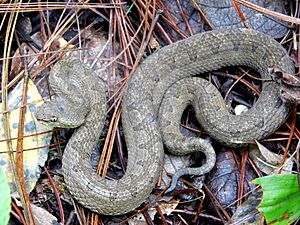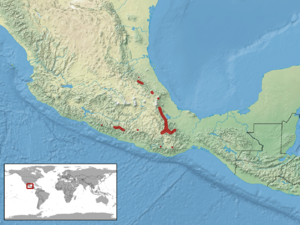Ophryacus undulatus facts for kids
Quick facts for kids Ophryacus undulatus |
|
|---|---|
 |
|
| Conservation status | |
| Scientific classification | |
| Genus: |
Ophryacus
|
| Species: |
undulatus
|
 |
|
| Synonyms | |
|
|
The Mexican horned pitviper (also known as the undulated pit viper) is a type of venomous pitviper. This snake species lives in the mountains of central and southern Mexico. Scientists currently do not recognize any different types (subspecies) of this snake.
Contents
What Does It Look Like?
Adult Mexican horned pitvipers usually grow to be about 55 to 70 centimeters (around 21 to 27 inches) long. They are quite sturdy snakes. A cool feature is the long, pointed scales above their eyes, which look like small "horns" or "spines."
Their body color is typically a shiny silvery-gray. On top, they have a pattern of black blotches that join together to form a wide, wavy stripe. You might also see black speckles on their sides. The very top of their head is black.
Where Does It Live?
This snake lives in the mountains of central and southern Mexico. You can find it in states like Hidalgo, Veracruz, Oaxaca, and Guerrero. It prefers higher places, living at elevations between 1,800 and 2,800 meters (about 5,900 to 9,200 feet) above sea level.
What Is Its Habitat Like?
The Mexican horned pitviper likes to live on brushy and rocky slopes. These areas are usually found near streams.
Conservation Status: Is It Endangered?
This snake is listed as Vulnerable (VU) on the IUCN Red List of Threatened Species. This means that the species is facing a high risk of disappearing from the wild.
Why Is It Vulnerable?
Scientists believe it's vulnerable because the area where it lives is getting smaller or is broken up into many small parts. Also, its habitat is declining in quality. In 2007, when it was last checked, the number of these snakes was going down.
Behavior
Even though the nights are cold where it lives, this snake seems to be active only during the day. People have often seen them coiled up on or near fallen logs. They also like to be in bushes and small trees, sometimes as high as 1 to 4 meters (about 3 to 13 feet) above the ground.
What Does It Eat?
The Mexican horned pitviper eats rodents and lizards.
Reproduction
This snake is ovoviviparous. This means that the females give birth to live young, instead of laying eggs. The eggs hatch inside the mother's body.


